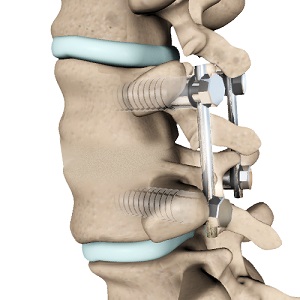
Introduction
The lower back or lumbar region consists of 5 vertebral bones that surround and protect the spinal cord. Wear and tear, trauma, disease or deformity can destabilize the spine and compress or damage the lumbar spinal cord and nerves that run between the vertebrae. This can lead to lower back pain as well as pain, numbness, or weakness in the legs.
Posterior lumbar fusion is a surgical procedure to join two or more adjacent vertebrae in the lumbar or lower back region in order to stabilize the spine and relieve pain. The procedure fixes the vertebral bones in an ideal position and limits movement that can cause pain.
Indications
Posterior lumbar fusion is recommended when symptoms affect your quality of life and are not relieved by conservative treatment. It is performed for a variety of spinal conditions including spinal fractures, slipping of vertebrae, infection, tumors, deformity or intervertebral disc disease.
Surgical procedure
- Posterior lumbar fusion is performed under general anesthesia.
- An incision is made in the midline of your back and the underlying muscles are separated.
- The spinal canal is accessed to remove bone at the back of the spinal cord as well as adjacent ligaments in order to relieve spinal cord or nerve compression.
- A bone graft from your own body or from a deceased donor is inserted either between the posterior parts of the vertebrae or in the disc space to stimulate bone growth and fusion.
- The bones are supported and stabilized by cages, screws, rods or plates
- After the completion of the procedure, the incision is closed leaving behind a minimal scar.
Post-Operative Care
Following the procedure, pain medication is prescribed and your back is supported in a brace until the vertebrae are adequately fused, about 6 weeks or longer.
You will be discharged from the hospital in 2-4 days and are advised on the activities you can perform and those you need to restrict.
Activities such as bending, twisting, and lifting heavy weights are restricted in the first 2-4 weeks after surgery. Return to work or normal activity depends on the type of work or activity you plan to perform.
Your doctor may recommend a rehabilitation program to strengthen your back muscles.
Risks and complications
As with any surgery posterior lumbar fusion may be associated with certain risks and complications such as
- Infection
- Bleeding
- Clot formation
- Nerve damage
- Persistent pain
Summary
Posterior lumbar fusion is a safe and reliable procedure that helps stabilize the lumbar spine and relieve pain. The surgery fixes the vertebral bones in an ideal position and limits movement between the vertebrae that can cause pain.

